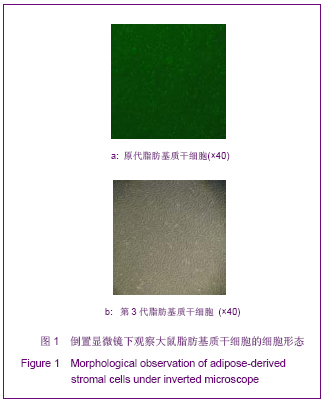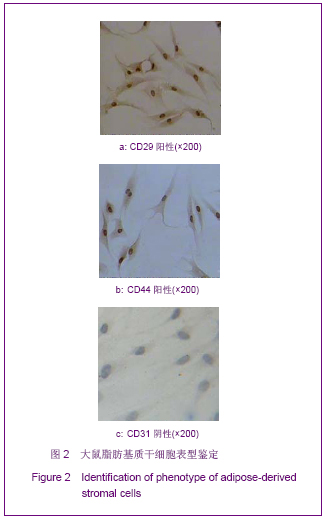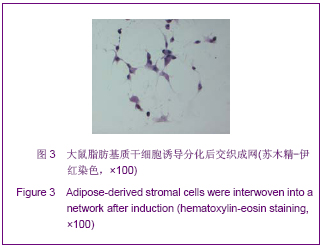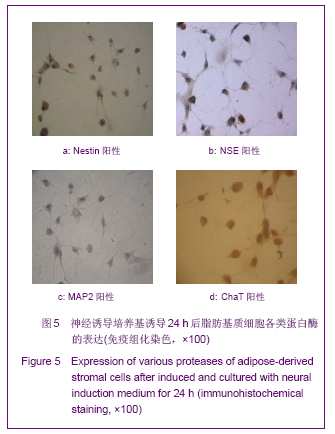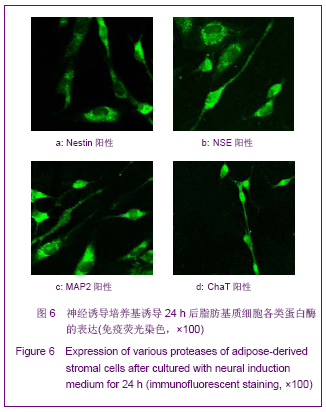| [1] Salgado AJ, Reis RL, Sousa NJ,et al.Adipose tissue derived stem cells secretome: soluble factors and their roles in regenerative medicine. Curr Stem Cell Res Ther. 2010;5(2): 103-110.[2] Xu L,Shen P,Hazel T,et al.Dual transplantation of human neural stem cells into cervica1 and 1um bar cord ameliorates motor neuron disease in SOD1 transgenic rats.Neurosci Lett. 2011;494(3):222-226.[3] Ashjian PH, Elbarbary AS, Edmonds B, et al. In vitro differentiation of human processed lipoaspirate cells into early neural progenitors. Plast Reconstr Surg.2003;111(6):1922-1931. [4] Liu B, Wu MH, Dong J, et al. Zhongguo Zuzhi Gongcheng Yanjiu yu Linchuang Kangfu. 2011;14(1):15-18.刘斌,吴孟海,董静,等.脂肪基质细胞诱导分化为神经元细胞的实验[J].中国组织工程研究与临床康复,2011,14(1):15-18. [5] Tang YP, Zhang HD, Zou YX, et al. Zhonghua Shenjing Yixue Zazhi. 2009;8(4):340-350.唐艳平,张洪钿,邹雨汐,等.大鼠脂肪基质细胞的分离培养及二步法诱导分化神经细胞[J].中华神经医学杂志,2009,8(4):340- 350.[6] The Ministry of Science and Technology of the People’s Republic of China. Guidance Suggestions for the Care and Use of Laboratory Animals.2006-09-30.[7] Dobashi Y, Kudoh T, Matsumine A,et al.Constitutive overexpression of CDK2 inhibits neuronal differentiation of rat pheochromocytoma PC12 cells.J Biol Chem.1995;270(39): 23031-23037. [8] Li DF,Yang C,Qu RM,et al.Cognitive improvement following transvenous adipose-derived mesenchymal stem cell transplantation in a rat model of traumatic brain injury.Neural Regen Res.2011;6(10):732-737.[9] Ou Y, Yuan XD, Cai YN,et al.A novel ethanol-based method to induce differentiation of adipose-derived stromal cells into astrocytes Neural Regen Res.2011;6(10):738-743.[10] Caspar-Bauguil S,Cousin B, GalinierA, et al. Adipose tissues as an ancestral immune organ: Site-specific change in obesity. FEBS Lett. 2005;579(17):3487-3892. [11] Horwitz EM. Stem cell plasticity: the growing potential of cellular therapy. Arch Med Res. 2003;34(6):600-606. [12] Gimble JM, Katz AJ, Bunnell BA.Adipose-derived stem cells for regenerative medicine.Circ Res.2007;100(9):1249-1260. [13] Prunet-Marcassus B, Cousin B, Caton D, et al.From heterogeneity to plasticity in adipose tissues: site-specific differences. Exp Cell Res. 2006;312(6):727-736.[14] De Ugarte DA, Alfonso Z, Zuk PA, et al. Differential expression of stem cell mobilization-associated molecules on multi-lineage cells from adipose tissue and bone marrow. Immunol Lett. 2003;89(2-3):267-270. [15] Strem BM, Hicok KC, Zhu M, et al. Multipotential differentiation of adipose tissue-derived stem cells. Keio J Med. 2005;54(3):132-141. [16] Xu Y, Liu Z, Liu L, et al. Neurospheres from rat adipose-derived stem cells could be induced into functional Schwann cell-like cells in vitro . BMC Neuroscience.2008; 9:21. [17] Gwak S, Bhang SH,Yang HS, et al. In vitro cardiomyogenic differentiation of adipose-derived stromal cells using transforming growth factor-β1.Cell Biochem Funct. 2009; 27(3):148-154. [18] Cousin B, Caspar-Bauguil S, Planat-Benard V, et al. Adipose tissue: asubtle and complex cell system. J Soc Biol. 2006; 200(1):51-57. [19] Lin Y, Chen X, Yan Z, et al. Multilineage differentiation of adipose-derived stromal cells from GFP transgenic mice. Mol Cell Biochem.2006;285(1-2):69-78.[20] Kang SK, Lee DH, Bae YC, et al. Improvement of neurological deficits by intracerebral transplantation of human adipose tissue-derived stromal cells after cerebral ischemia in rats. Experimental Neurology.2003;183(2):355-366.[21] Wislet-Gendebien S, Hans G, Leprince P, et al. Plasticity of cultured mesenchymal stem cells: switch from nestin-positive to excitable neuron-like phenotype. Stem Cells. 2005;23(3): 392-402.[22] Ye CQ, Yuan XD, Liu H,et al.Ultrastructure of neuronal-like cells differentiated from adult adipose-derived stromal cells. NEURAL REGEN RES.2010;5(19):1456-1463.[23] Wunderlich MT,Lins H,Skalej M,et al.Neuron specific enolase and tauprotein as neurobiochemical markers of neuronal damage are related to early clinical course and long-term outcome in acute ischemic stoke.Clin Neurol Neurosury. 2006;108(6):558-563. [24] Wang F,Chen H, Sun X.Age-related spatial cognitive impairment is correlated with a decrease in ChAT in the cerebral cortex,hippocampus and forebrain of SAMP8 mice.Neurosci Lett.2009;454(3):212-217. |
